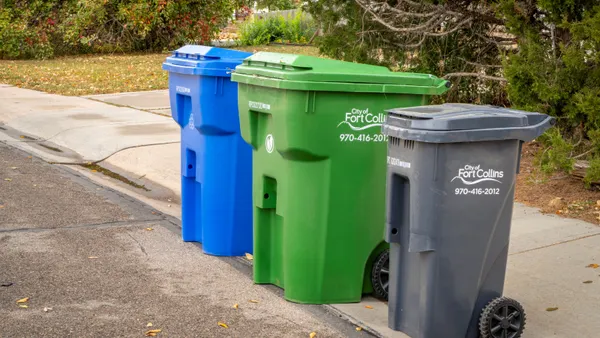Dive Brief:
- A new study in Science Advances has found the total weight of virgin plastic ever produced is 8.3 billion metric tons. As of 2015, there have been at least 6.3 million metric tons of plastic waste produced. Only 9% has been recycled; 12% has been incinerated, and 79% has been landfilled or wound up in the natural environment.
- The study says that, if current plastic trends continue, there will be nearly 12 billion metric tons of plastic waste in landfills or the natural environment by 2050.
- As pointed out in The Washington Post, that's more than enough plastic for everyone on earth to have a literal ton of plastic garbage. As observed by the Associated Press, that's enough waste to bury Manhattan in two miles of garbage.
Dive Insight:
Millions of pounds of plastic waste end up in the Great Lakes each year, billions of pieces of plastic waste litter the Arctic Ocean and rivers pour up to 2.41 million metric tons of plastic into the ocean each year. Clearly, plastic waste is a global problem — and it's only getting more severe. Each second, there are 20,000 plastic bottles purchased. Cities in the United States, like Chicago, have struggling recycling programs.Two-thirds of recyclable plastic packaging in the United Kingdom go un-recycled. And a proposed import ban in China could disrupt global supply chains of plastic scrap waste.
There is plenty of room in the waste and recycling industry to innovate and improve how plastic waste is handled — though it is safe to a say that a multi-layered, holistic approach will be necessary to tackle such a massive problem. Plastic-to-fuel facilities, while feasible, haven't taken off in a big way — so that isn't a silver bullet. Recycling programs in different cities can boast high participation rates, but many struggle with high contamination rates — so that isn't a silver bullet. Banning certain plastic products, like shopping bags, can divert some waste, but bag bans are legislatively complicated — so that isn't a silver bullet. Education programs are useful, but they can be overwhelming or ignored — so that isn't a silver bullet. These mitigation tools are all effective, and all necessary, but none of them will work alone. The solutions and innovations that reduce the amount of plastic waste pollution will have to come from partnerships between governments and the public sector, not from any lone actor.








